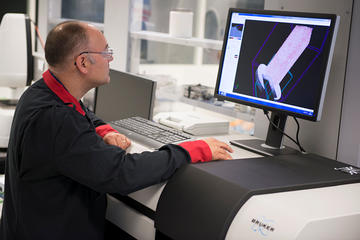
Bruker Skyscan 1172
© NNL
A high-resolution X-ray CT capability is available for use at UKNNL’s Central Laboratory. Installed in the active area of Central Laboratory on Sellafield site, the Bruker Skyscan 1172 allows non-destructive imaging of specimens with a peak resolution of 0.9 μm.
Comprising a 100 kV, 10 W X-ray source, 11 MP CCD detector, and a micropositioning stage, the 1172 is capable of scanning samples as large as 50 mm in diameter and can perform z-stacking for particularly long specimens.
Previously the instrument has been involved in examining carbonaceous deposits, uranium foil in cement, Magnox simulant sludge, various cements and grouts.
Technical contact: Dr Matthew Jordan (matthew.jordan@uknnl.com) & Dr Tamsin O’Reilly (tamsin.i.oreilly@uknnl.com)